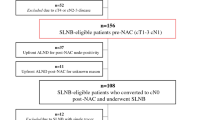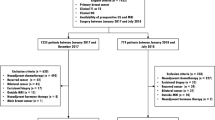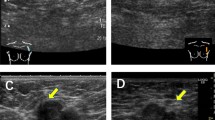Abstract
Background
The National Comprehensive Cancer Network (NCCN) endorses sentinel lymph node biopsy (SLNB) in patients with clinically positive axillary nodes who downstage after neoadjuvant chemotherapy (NAC). In this study, we compared the accuracy of post-NAC MRI to clinical exam alone in predicting pathologic status of sentinel lymph nodes in cN1 patients.
Methods
We identified patients with T0-3, N1 breast cancer who underwent NAC and subsequent SLNB from March 2014 to July 2017. Patients were grouped based on whether a post-NAC MRI was done. MRI accuracy in predicting SLN status was assessed versus clinical exam alone.
Results
A total of 450 patients met initial study criteria; 269 were analyzed after excluding patients without biopsy-confirmed nodal disease, palpable disease after NAC, and failed SLN mapping. Median age was 49 years. Post-NAC MRI was done in 68% (182/269). Patients undergoing lumpectomy vs mastectomy more frequently received a post-NAC MRI (88 vs 54%, p < 0.001). All other clinicopathologic parameters were comparable between those who did and did not have a post-NAC MRI. Thirty percent (55/182) had abnormal lymph nodes on MRI. Among these, 58% (32/55) had a positive SLN on final pathology versus 42% (53/127) of patients with no abnormal lymph nodes on MRI and 52% (45/87) of patients who had clinical exam alone (p = 0.09). MRI sensitivity was 38%, specificity was 76%, and overall SLN status prediction accuracy was 58%.
Conclusions
Post-NAC MRI is no more accurate than clinical exam alone in predicting SLN pathology in patients presenting with cN1 disease. Abnormal lymph nodes on MRI should not preclude SLNB.

Similar content being viewed by others
References
El Hage Chehade H, Headon H, El Tokhy O, Heeney J, Kasem A, Mokbel K. Is sentinel lymph node biopsy a viable alternative to complete axillary dissection following neoadjuvant chemotherapy in women with node-positive breast cancer at diagnosis? An updated meta-analysis involving 3,398 patients. Am J Surg. 2016;212(5):969–981.
Kuehn T, Bauerfeind I, Fehm T, et al. Sentinel-lymph-node biopsy in patients with breast cancer before and after neoadjuvant chemotherapy (SENTINA): a prospective, multicentre cohort study. Lancet Oncol. 2013;14(7):609–618.
Boughey JC, Suman VJ, Mittendorf EA, et al. Sentinel lymph node surgery after neoadjuvant chemotherapy in patients with node-positive breast cancer: the ACOSOG Z1071 (Alliance) clinical trial. JAMA. 2013;310(14):1455–1461.
Boileau JF, Poirier B, Basik M, et al. Sentinel node biopsy after neoadjuvant chemotherapy in biopsy-proven node-positive breast cancer: the SN FNAC study. J Clin Oncol. 2015;33(3):258–264.
Network NCC. Clinical practice guidelines oncology—breast cancer (version 3.2018). 2018; https://www.nccn.org/professionals/physician_gls/pdf/breast.pdf. Accessed 28 Jan 2018.
Schwentner L, Helms G, Nekljudova V, et al. Using ultrasound and palpation for predicting axillary lymph node status following neoadjuvant chemotherapy: results from the multi-center SENTINA trial. Breast. 2017;31:202–207.
Mamtani A, Barrio AV, King TA, et al. How often does neoadjuvant chemotherapy avoid axillary dissection in patients with histologically confirmed nodal metastases? Results of a prospective study. Ann Surg Oncol. 2016;23(11):3467–3474.
Lobbes MB, Prevos R, Smidt M, et al. The role of magnetic resonance imaging in assessing residual disease and pathologic complete response in breast cancer patients receiving neoadjuvant chemotherapy: a systematic review. Insights Imaging. 2013;4(2):163–175.
Croshaw R, Shapiro-Wright H, Svensson E, Erb K, Julian T. Accuracy of clinical examination, digital mammogram, ultrasound, and MRI in determining postneoadjuvant pathologic tumor response in operable breast cancer patients. Ann Surg Oncol. 2011;18(11):3160–3163.
Classe JM, Bordes V, Campion L, et al. Sentinel lymph node biopsy after neoadjuvant chemotherapy for advanced breast cancer: results of Ganglion Sentinelle et Chimiotherapie Neoadjuvante, a French prospective multicentric study. J Clin Oncol. 2009;27(5):726–732.
Marinovich ML, Houssami N, Macaskill P, et al. Meta-analysis of magnetic resonance imaging in detecting residual breast cancer after neoadjuvant therapy. J Natl Cancer Inst. 2013;105(5):321–333.
Park J, Chae EY, Cha JH, et al. Comparison of mammography, digital breast tomosynthesis, automated breast ultrasound, magnetic resonance imaging in evaluation of residual tumor after neoadjuvant chemotherapy. Eur J Radiol. 2018;108:261–268.
Lee MC, Gonzalez SJ, Lin H, et al. Prospective trial of breast MRI versus 2D and 3D ultrasound for evaluation of response to neoadjuvant chemotherapy. Ann Surg Oncol. 2015;22(9):2888–2894.
Weber JJ, Jochelson MS, Eaton A, et al. MRI and prediction of pathologic complete response in the breast and axilla after neoadjuvant chemotherapy for breast cancer. J Am Coll Surg. 2017;225(6):740–746.
Scheel JR, Kim E, Partridge SC, et al. MRI, Clinical examination, and mammography for preoperative assessment of residual disease and pathologic complete response after neoadjuvant chemotherapy for breast cancer: ACRIN 6657 Trial. AJR Am J Roentgenol. 2018;210(6):1376–1385.
Steiman J, Soran A, McAuliffe P, et al. Predictive value of axillary nodal imaging by magnetic resonance imaging based on breast cancer subtype after neoadjuvant chemotherapy. J Surg Res. 2016;204(1):237–241.
Hieken TJ, Boughey JC, Jones KN, Shah SS, Glazebrook KN. Imaging response and residual metastatic axillary lymph node disease after neoadjuvant chemotherapy for primary breast cancer. Ann Surg Oncol. 2013;20(10):3199–3204.
Mattingly AE, Mooney B, Lin HY, et al. Magnetic resonance imaging for axillary breast cancer metastasis in the neoadjuvant setting: a prospective study. Clin Breast Cancer. 2017;17(3):180–187.
Javid S, Segara D, Lotfi P, Raza S, Golshan M. Can breast MRI predict axillary lymph node metastasis in women undergoing neoadjuvant chemotherapy. Ann Surg Oncol. 2010;17(7):1841–1846.
Hyun SJ, Kim EK, Moon HJ, Yoon JH, Kim MJ. Preoperative axillary lymph node evaluation in breast cancer patients by breast magnetic resonance imaging (MRI): Can breast MRI exclude advanced nodal disease? Eur Radiol. 2016;26(11):3865–3873
Boughey JC, Ballman KV, Hunt KK, et al. Axillary ultrasound after neoadjuvant chemotherapy and its impact on sentinel lymph node surgery: results From the American College of Surgeons Oncology Group Z1071 Trial (Alliance). J Clin Oncol. 2015;33(30):3386–3393.
Acknowledgment
The preparation of this study was funded in part by NIH/NCI Cancer Center Support Grant No. P30 CA008748 to Memorial Sloan Kettering Cancer Center. This study was presented in podium format at the Society of Surgical Oncology 72nd Annual Cancer Symposium, March 27–30, 2019, San Diego, CA.
Author information
Authors and Affiliations
Corresponding author
Ethics declarations
Disclosures
Dr. Monica Morrow has received speaking honoraria from Genomic Health and Roche. Dr. Mahmoud El-Tamer received honoraria from Blue Earth Diagnostic in 2016. All other authors have no conflict of interest disclosures to report.
Additional information
Publisher's Note
Springer Nature remains neutral with regard to jurisdictional claims in published maps and institutional affiliations.
Rights and permissions
About this article
Cite this article
Moo, TA., Jochelson, M.S., Zabor, E.C. et al. Is Clinical Exam of the Axilla Sufficient to Select Node-Positive Patients Who Downstage After NAC for SLNB? A Comparison of the Accuracy of Clinical Exam Versus MRI. Ann Surg Oncol 26, 4238–4243 (2019). https://doi.org/10.1245/s10434-019-07867-x
Received:
Published:
Issue Date:
DOI: https://doi.org/10.1245/s10434-019-07867-x




